Authors: Thiago Roberto Gemeli and Rafael Cecato
The use of total prostheses is extremely widespread in the Brazilian population. They represent an easily accessible alternative in the treatment of edentulism and, in most of their applications, enable the functional and aesthetic rehabilitation desired by patients. However, reports associated with their disadvantages are not uncommon, being mainly associated with ease of release and loss of chewing efficiency. This occurs mainly as a result of the loss of anatomic volume and functional wear of these devices. Therefore, these incidents tend to increase over the years, consequently compromising retention of the prostheses, which in some situations can be severely affected, significantly impairing the quality of life of these users.
One of the alternatives to increase the retention of total prosthesis is to anchor it on various implants. Unlike fully implant-supported prostheses (protocols), implant-mucosal-supported prostheses (overdentures) maintain direct contact with oral tissues. Its differentials are associated with a lower number of dental implants for anchoring, as well as the low cost involved for its execution compared to the protocols.
Furthermore, unlike the protocols, overdentures do not always require the fabrication of a new prosthesis. Sometimes the patient’s total prosthesis can be adapted to the implants that will be installed, with the dental surgeon evaluating and stipulating these criteria (time of use, level of wear and adaptation, aesthetics, patient interest, etc.).
To exemplify this condition, see below the clinical case report:
Female patient, 53 years old, sought treatment at a private dental clinic with the intention of increasing retention of the lower total prosthesis that she used. The patient reported that she had gotten the device less than a year ago, but it did not have sufficient stability when subjected to the masticatory function. Two Arcsys implants were installed in the mandibular region, which, after osseointegration, allowed the coupling of mini-abutment-type prosthetic components. On these, tilting capsules were adapted and they were immediately captured by the patient’s own prosthesis, with the help of chemically activated acrylic resin (CAAR).
The clinical stages obeyed the following order:
- Initial tomographic evaluation
- Adjustment of ridge
- Single drilling for placement of Arcsys implants
The FGM Overdenture System allows total prosthesis stabilization with an added advantage over other systems available on the market, mainly due to the option of customizable prosthetic components, enabling axes that are more parallel to each other, as well as the tilting mobility of the smart overdenture capsules. The association of these unique characteristics in this segment provides better biomechanical conditions, favoring usability and, as everything indicates, promotes greater longevity of the retention mechanism
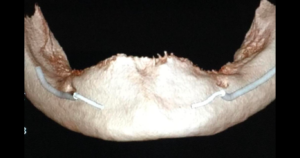
Initial Tomography.
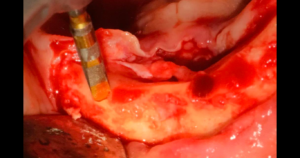
Adjustment of ridge
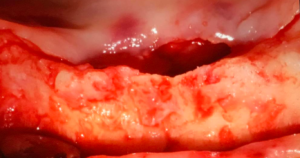
Single drilling for placement of Arcsys implants.
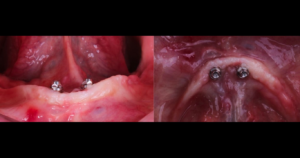
Placement of Mini Abutments on Arcsys Implants. a) Front view; b) Occlusal view.
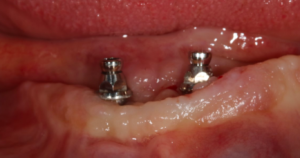
Placing the Arcsys Smart Overdenture Screws.
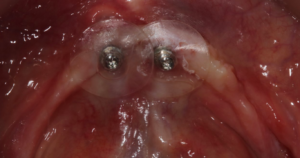
Placing Smart Overdenture Protection Discs.
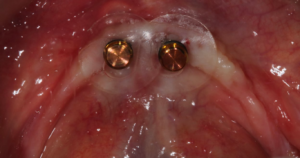
Fitting the Smart Overdenture Capsules on the Arcsys Smart Overdenture Screws.

Total lower prosthesis. a) Occlusal view; b) Bottom view.
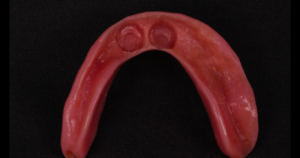
Fabricating niches to place the Smart Overdenture Capsules.
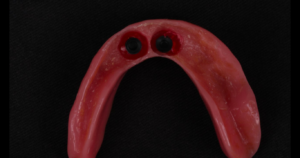
Bottom view of the prosthesis, after capturing the capsules and filling the niches with chemically activated acrylic resin. (CAAR).
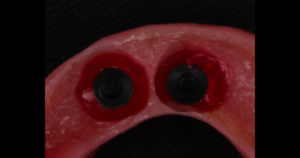
No En el detalle, vista inferior de la prótesis tras la captura de las cápsulas y rellenado de los nichos con RAAQ. Observe la presencia de los retentoreslaboratoriales (polímero negro), utilizados para protección de las cámaras internas de las cápsulas. In detail, lower view of the prosthesis after capturing the capsules and filling the niches with CAAR. Note the presence of the laboratory retainers (black polymer), used to protect the internal chambers of the capsules.

Overdenture Retainer Tool, used to remove Laboratory Overdenture Retainers and insert Smart Overdenture Capsules.
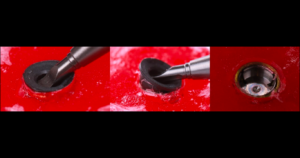
To remove the Laboratorial Overdenture Retainer, pinch it with the removal tool (A) and promote a leverage action (B).
This maneuver will allow access to the internal chamber of the Smart Overdenture Capsule. (C).
Important: remove the retainer only after complete cure of the CAAR.
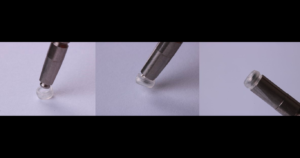
Promote engagement of the Smart Overdenture Retainer at the end of the insertion tool (D,E,F).
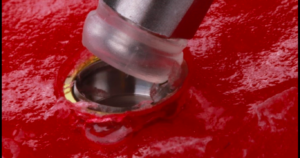
Fit the Smart Overdenture Retainer, under pressure, into the inner chamber of the Smart Overdenture Capsule.
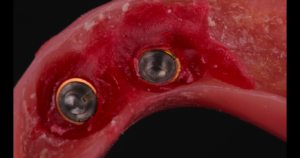
Detailed view of the strong retainer duly attached to the Smart Overdenture Capsule, prior to finishing and polishing the region.

Implant-muco-supported total prosthesis adapted to the patient.







